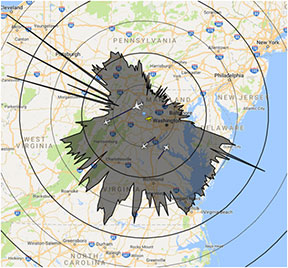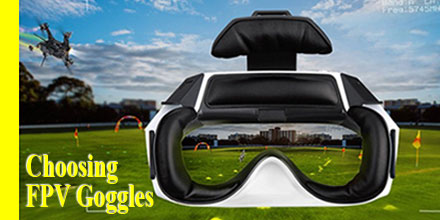
First-person-view (FPV) goggles are all the rage. FPV goggles, allow the wearer to see the flight and the surrounding environment through the drone’s camera.
FPV is an immersive perspective, to say the least, and a growing trend for drone operators beyond the quad-racer set.
So, if you're thinking of purchasing FPV video goggles, there are a few critical elements users should consider before making a purchase.
FPV: flying made easier?
FPV goggles connect via WiFi to the camera mounted on the drone using a series of small adapters and frequencies. Basically, FPV goggles allow the wearer to see the flight and the surrounding environment through the drone’s camera.
This perspective is, of course, appealing to operators for several reasons. Drone operators find that FPV goggles make it easier to fly; obstructions are more easily navigated and shots are more easily captured. Before FPV goggles, certain shots were difficult if not impossible to capture because of the pilots need to see the drone at all times.
Field of View: larger is better
For the ultimate experience, experts recommend FPV goggles with the largest clear field of view (FOV). FOV is defined as “the extent of the observable world that is seen at any given moment.” As such, the larger the degree, the larger the field of view. Preferably, this view should extend to the corners of the display.
FPV goggles, on average, cover a view range between 37 to 60 degrees. For perspective, a 60-degree FOV is similar to watching a 125-inch screen in your living room. The larger the fields of view the more closely it matches the view of the drone camera. It also give the pilot a less distorted view which, of course, helps with flight operations.
The size and weight of goggles
FPV goggles range in size. Some are as small as a pair of sunglasses. Others are as big as a virtual reality headset. Usually, the larger the goggles the larger the viewing screen. However, the weight and comfort of the headset is also an important consideration.
Heavier goggles can be cumbersome and difficult to wear over long periods of time. Some users can even experience strain along the back of the neck, bridge of the nose, and eye sockets.
Smaller goggles are easier to wear but some can feel cheaply constructed. For those on the fence about this technology, purchasing a more affordable pair is a smart way to figure out if its a match or not. Some operators find that FPV goggles aren't a great option for their flight and personal preferences.
Camera Controls
Some higher-end FPV goggles allow users to manipulate the camera settings – zoom, pan/tilt, the direction it points – if the camera mechanism allows. Keep in mind, not all FPV googles offer camera controls and the ones that do, range in functionality. Either way, the radio controller allows for camera control.
Some users prefer direct camera control via the goggles, others do not. One of the major drawbacks cited by users is the need to take a hand off the radio control, mid-flight, to make any needed camera or goggle display adjustments. Some operators prefer not to have that distraction.
FPV antenna and positioning
All FPV goggles are equipped with antennas and internal transmitters which allow the goggles to sync with the drone’s camera. Antennas are either internally or externally placed. The position of the antenna is vitally important. In fact, the antenna -- and it's position -- is probably one of the most important considerations when choosing FPV Goggles.
Some FPV kits include antennas, which are most often cloverleaf antennas. Cloverleaf are omnidirectional, circular polarized antennas -- which work very well for FPV. Of course, more experienced operators usually choose to alter the setup for a system geared to their particular needs.
Selecting for the application
One of the final considerations when selecting FPV goggles is application.
Racing and agile flight drone operators often choose larger headset style goggles. These also usually have more FOV settings from which to choose. FOV adjustments allow the operator to see more detail and a wider view which is useful for racing and acrobatic flight operations.
Also, FPV goggles with zero latency are crucial to experiencing flight with delay or lag. Quad racers tearing around the track at 80mph, cannot afford to have a delay in the video transmission -- which translates into missed obstacles and crashes.
Smaller goggles are often the choice for everyday and videography operators. These applications require higher resolution and enhanced capture features so it is easier to get great shots. Often, these goggles have reduced FOV in exchange for a better output resolution.
Final considerations
Outside quad racing, adding FPV goggles to a system comes down to personal preference. Though some operators enjoy the immersive experience goggles provide, others simply do not. So, whether to FPV or not? The decision is up to you.
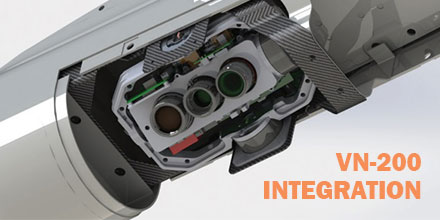 VectorNav announced that its VN-200 GPS-aided inertial navigation system (INS) was selected for integration into Overwatch Imaging‘s TK-series precision imaging payload.
The payload is for aerial smart mapping and automatic detection applications for UAVs (unmanned aerial vehicles) and manned aircraft.
VectorNav announced that its VN-200 GPS-aided inertial navigation system (INS) was selected for integration into Overwatch Imaging‘s TK-series precision imaging payload.
The payload is for aerial smart mapping and automatic detection applications for UAVs (unmanned aerial vehicles) and manned aircraft.

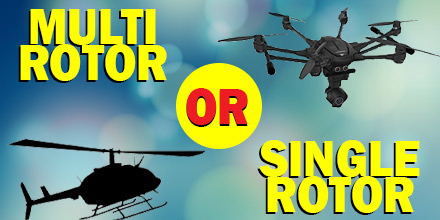 Although multi-rotor drones get most of the attention in the UAV world today, they’re not the only option for a flight project. But why would someone choose a multi-rotor over a single-rotor...or vice versa? Read on to learn the differences between the two, as well as their strengths and weaknesses.
A key difference between the two, not surprisingly, is the number of rotors each offers. A multi-rotor aerial vehicle has several rotors that keep it airborne. In contrast, a single-rotor vehicle has one rotor plus a tail rotor to control its heading.
Although multi-rotor drones get most of the attention in the UAV world today, they’re not the only option for a flight project. But why would someone choose a multi-rotor over a single-rotor...or vice versa? Read on to learn the differences between the two, as well as their strengths and weaknesses.
A key difference between the two, not surprisingly, is the number of rotors each offers. A multi-rotor aerial vehicle has several rotors that keep it airborne. In contrast, a single-rotor vehicle has one rotor plus a tail rotor to control its heading.
 The power to extend flight time while in the field just got a little easier thanks to Colorado Drone Chargers.
Formerly known as P-Squared Group, Colorado Drone Chargers is a leading designer and manufacturer of rapid charging systems for unmanned aerial vehicles.
The company focuses exclusively on charging technology and ease of use for the customer.
The complete line of Portable Rapid Charging Systems (PRCS) is now available at Unmanned Systems Source.
“Our mission is to make and market the best products,” said Johnny Podrovitz, founder of Colorado Drone Chargers. “From day one, we have been committed to delivering exceptional products for the drone battery charging industry.”
The power to extend flight time while in the field just got a little easier thanks to Colorado Drone Chargers.
Formerly known as P-Squared Group, Colorado Drone Chargers is a leading designer and manufacturer of rapid charging systems for unmanned aerial vehicles.
The company focuses exclusively on charging technology and ease of use for the customer.
The complete line of Portable Rapid Charging Systems (PRCS) is now available at Unmanned Systems Source.
“Our mission is to make and market the best products,” said Johnny Podrovitz, founder of Colorado Drone Chargers. “From day one, we have been committed to delivering exceptional products for the drone battery charging industry.”
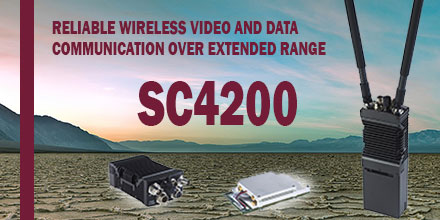 The StreamCaster 4200 (SC4200) radio by Silvus Technologies was recently selected by MILREM, a manufacturer of Unmanned Ground Vehicles (UGV) based in Estonia. MILREM will integrate the SC4200 onto the Tracked Hybrid Modular Infantry System (THeMIS) platform.
THeMIS UGV is an intelligence, surveillance and reconnaissance (ISR) platform. It assists with target acquisition, logistics support, and other missions.
The SC4200 serves as the datalink, providing wireless command/control and video. It pairs with high performance antennas to allow the THeMIS to drive extended ranges, and push video and data communication farther than before.
“Silvus is offering rugged and high quality MIMO radios which have proven to provide reliable wireless video and data communication over extended range,” said Rivo Opik, MILREM’s Chief Engineer. “The technical support and guidance from the Silvus team has been quick and very effective.”
SC4200 2x2 MIMO radio features transmit beamforming which nearly doubles the signal range. The ability to significantly extend range is why MILREM choose the SC4200 for the THeMIS. Companies purchasing the THeMIS can control, one, two or an entire fleet of these UGVs. In addition, users can monitor what is happening using a real-time, live HD-video feed from the Silvus radios.
The StreamCaster 4200 (SC4200) radio by Silvus Technologies was recently selected by MILREM, a manufacturer of Unmanned Ground Vehicles (UGV) based in Estonia. MILREM will integrate the SC4200 onto the Tracked Hybrid Modular Infantry System (THeMIS) platform.
THeMIS UGV is an intelligence, surveillance and reconnaissance (ISR) platform. It assists with target acquisition, logistics support, and other missions.
The SC4200 serves as the datalink, providing wireless command/control and video. It pairs with high performance antennas to allow the THeMIS to drive extended ranges, and push video and data communication farther than before.
“Silvus is offering rugged and high quality MIMO radios which have proven to provide reliable wireless video and data communication over extended range,” said Rivo Opik, MILREM’s Chief Engineer. “The technical support and guidance from the Silvus team has been quick and very effective.”
SC4200 2x2 MIMO radio features transmit beamforming which nearly doubles the signal range. The ability to significantly extend range is why MILREM choose the SC4200 for the THeMIS. Companies purchasing the THeMIS can control, one, two or an entire fleet of these UGVs. In addition, users can monitor what is happening using a real-time, live HD-video feed from the Silvus radios.
 First-person-view (FPV) goggles are all the rage. FPV goggles, allow the wearer to see the flight and the surrounding environment through the drone’s camera.
FPV is an immersive perspective, to say the least, and a growing trend for drone operators beyond the quad-racer set.
So, if you're thinking of purchasing FPV video goggles, there are a few critical elements users should consider before making a purchase.
First-person-view (FPV) goggles are all the rage. FPV goggles, allow the wearer to see the flight and the surrounding environment through the drone’s camera.
FPV is an immersive perspective, to say the least, and a growing trend for drone operators beyond the quad-racer set.
So, if you're thinking of purchasing FPV video goggles, there are a few critical elements users should consider before making a purchase.
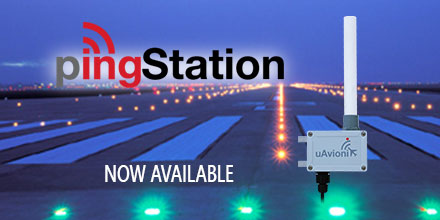 uAvionix Corporation, the leading Unmanned Aircraft System (UAS) avionics solution provider, recently announced the introduction of PingStation.
uAvionix Corporation, the leading Unmanned Aircraft System (UAS) avionics solution provider, recently announced the introduction of PingStation.
